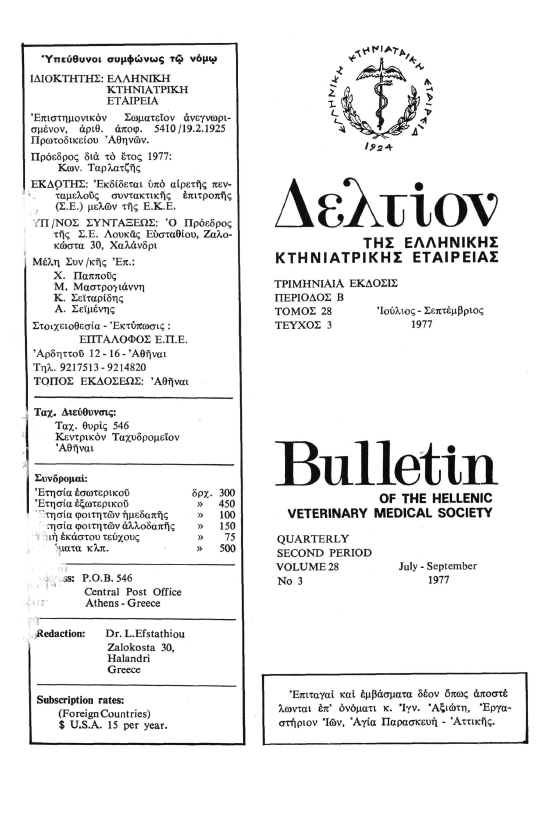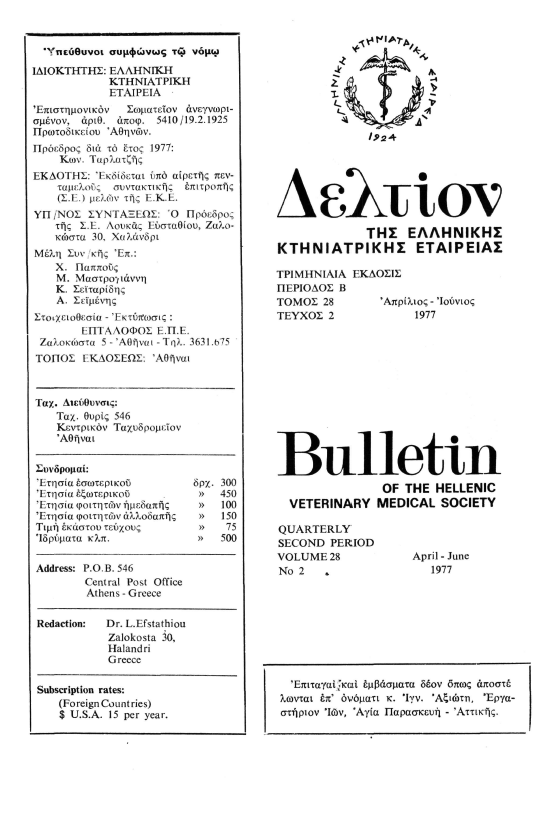Παρατηρήσεις τινές επί της γονιμότητος των αίγών κατόπιν συγχρονισμού του οιστρου και τεχνητής σπερματεγχύσεως
Abstract
1. Κατά τήν πα ρούσα ν έργασίαν διηρευνήθη ή άποτελεσματικότης του συγχρονισμού του οίστρου έπί εριφίων, βιτουλίων καί ενηλίκων αίγών μέ το προγεσταγόνον MAP (50mg) καί τήν γοναδοτρόπον ορμόνην PMS (500 Δ.Μ.) κατά τήν οίστρικήν περίοδον. Τήν 48ην καί 72αν ώραν αφαιρέσεως τών σπόγγων καί της χορηγήσεως τοΰ PMS, έφηρμόσθη τεχνητή σπερματέγχυσις μέ νωπόν σπέρμα. 2. Tò ποσοστον γονιμότητος είς τα ερίφια, τα βιτούλια και τάς αίγας άνηλθεν είς 60,0%, 58,3% και 61,1% ό δέ συντελεστής πολυδυμίας είς 1,77, 1,87 και 1,95% αντιστοίχως. 3. Είς τα βιτούλια μέ σωματικόν βάρος μικρότερον των 3 5 Kg παρετηρήθη χαμηλον ποσοστόν γονιμότητος (16,6%). 4. Έκ της παρούσης έρεύνης συμπεραίνεται ότι, τα ερίφια καί τα βιτούλια μέ κανονικήν άνάπτυξιν ανταποκρίνονται καλώς είς την άγωγήν τοΰ συγχρονιμοΰ τοΰ οίστρου δυνάμενα να χρησιμοποιηθούν δι' άναπαραγωγήν άνευ επιφυλάξεως
Article Details
- Come citare
-
ΕΛΕΥΘΕΡΙΟΥ Ε., & ΚΟΥΤΣΟΥΡΗΣ Χ. (2019). Παρατηρήσεις τινές επί της γονιμότητος των αίγών κατόπιν συγχρονισμού του οιστρου και τεχνητής σπερματεγχύσεως. Journal of the Hellenic Veterinary Medical Society, 28(3), 123–128. https://doi.org/10.12681/jhvms.21301
- Fascicolo
- V. 28 N. 3 (1977)
- Sezione
- Articles

Questo lavoro è fornito con la licenza Creative Commons Attribuzione - Non commerciale 4.0 Internazionale.
Authors who publish with this journal agree to the following terms:
· Authors retain copyright and grant the journal right of first publication with the work simultaneously licensed under a Creative Commons Attribution Non-Commercial License that allows others to share the work with an acknowledgement of the work's authorship and initial publication in this journal.
· Authors are able to enter into separate, additional contractual arrangements for the non-exclusive distribution of the journal's published version of the work (e.g. post it to an institutional repository or publish it in a book), with an acknowledgement of its initial publication in this journal.
· Authors are permitted and encouraged to post their work online (preferably in institutional repositories or on their website) prior to and during the submission process, as it can lead to productive exchanges, as well as earlier and greater citation of published work.




